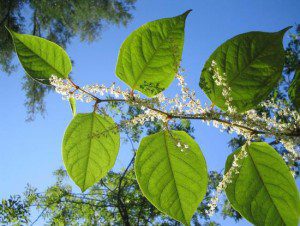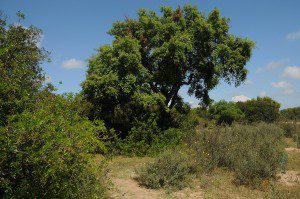Northern Portugal: the new nature destination
Peneda Geres National Park © Joao Farinha
Northern Portugal is pioneering in the field of Sustainable Tourism: for the first time, a regional strategy and a governance model were created, bringing together over 15 governmental and non-governmental organisations related with tourism and nature conservation. The Consortium “Natural North – Nature Tourism in the Northern Region” was officially announced on the 9th of April, with the presence of the State Secretary of Land Planning and Nature Conservation, Mrs. Célia Ramos, and EUROPARC Executive Director, Mrs. Carol Ritchie.
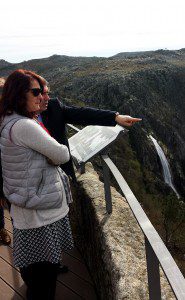
Magic Mountains, Montanhas Mágicas www.montanhasmagicas.com/en/
Northern Portugal is already one of the most astonishing areas for nature tourism. Over 22.000 km2 of land that surprises the visitors with its scenic granitic landscapes, beautiful forests, water streams flowing in unexpected waterfalls, and rough, mountain lands, shaped by men over centuries.
For this reason, 25% of this territory is protected, comprising the only Portuguese National Park (Peneda-Geres), 4 Nature Parks, 2 Geoparks, 2 cross-border Biosphere Reserves, 2 World Heritage Cultural Landscapes, 19 Natura 2000 areas and 6 Sustainable Destinations awarded with the Charter for Sustainable Tourism in Protected Areas (Peneda-Gerês, Montesinho, Alvão, Douro Internacional, Montanhas Mágicas and Alto Minho).
A strategy for Nature Tourism
The Consortium “Natural North” is the first of its kind for such a wide area. It aims to develop an integrated offer for Nature Tourism at a regional scale, and a joint promotion of the territory, in order to increase national and international visibility.
Porto and Northern Portugal will be recognised has one of the main nature tourism destinations in Portugal
stated Melchior Moreira, President of the Tourism of Porto and North Agency, the governmental body that led the initiative.
The regional strategy, based on the Action Plans of each Sustainable Destinations awarded with theCharter for Sustainable Tourism (ECST), follows the principles established by the EUROPARC Federation.
Carol Ritchie, EUROPARC Director, praised the Consortium for this initiative, asserting that “sustainability can only be achieved through cooperation and a common vision for the territory”.
The current effort in enhancing the level of cooperation in Northern Portugal is remarkable, and sets up a new direction of managing and promoting wider regional areas in Europe, for the benefit of people and nature.
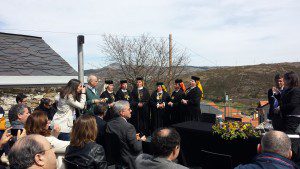
Ceremony with a performance of traditional singers
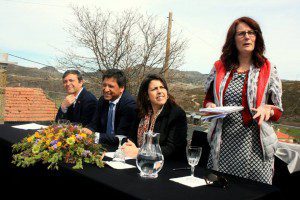
Melchior Moreira (President of Tourism Porto and North Portugal), Artur Neves (President of Arouca Municiplaity), Célia Ramos (State Secreatry), Carol Ritchie (Europarc Director)
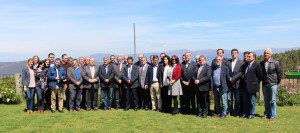
The Consurtium “Natural North”
The ECST is a practical management tool that enables Protected Areas to develop tourism sustainably. It is managed by the EUROPARC Federation and verified through an independent process. To learn more about the charter read the brochure Good for Parks, Good for People.
Forest management and protected areas
Protected areas staff face several challenges in the management of their forests. Dealing with invasive species, promoting regeneration, using effective monitoring systems, or simply understanding the policy framework within the European Union are just some of them. Indeed, similar problems arise in different protected areas, therefore exchanging experiences and best practices can be a great way to locally solve them.
EUROPARC suggest you 4 interesting opportunities – workshops and conferences, where you will share your experience and learn from other protected area managers.
Managing invasive plant and animal species in the protected areas of Central and Eastern Europe
Workshop, 2nd May 2016 – Hortobágy National Park (Hungary)
Experts from protected areas of Central and Eastern Europe will share their practical experience on how to combat invasive/alien species. The workshop is organised by the Central and Eastern Europe Section and is based on a simple idea: to organize cost effective workshops for „our own” experts to collect relevant experience on nature protection practices. Read more about it here.
Mediterranean forest management and Natura 2000
Workshop, 9th – 11th May 2016 – Parc Naturel Régional du Luberon
Under the framework of the Natura 2000 Biogeographical Process for the Mediterranean Region, Parc naturel regional du Luberon will host a workshop focused on current issues in Mediterranean forest management. During two days, participants will learn about integrated management approaches that benefit both forestry and nature conservation through plenary sessions, field trips and interactive sessions. The challenges and opportunities of promoting ecological connectivity through integrated planning will be the main discussion topic. Therefore, to provide participants an overview of European implemented systems, professionals from France, Portugal, Italy and Greece will share their expertise and local experiences on the management of Mediterranean forests.
Policy conference, 23rd May 2016 – European Commission, Brussels
Do you know the many services which Europe’s forest ecosystems deliver to us? Are you working to ensure that the prosperity and benefits provided by forests to citizens will continue for the future? Meet key players in the field, get new insights, follow the debates, and have your say on what needs to be done and how the EU can help. More information here.
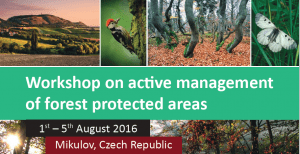
Workshop forest management
Workshop, 1st-5th August 2016 – Mikulov, Czech Republic
Are there risks for biodiversity on simply setting aside forests for free development? Are forests able to recover by themselves, in the context of a Europe with a historical intensive use of land and fragmented landscapes? To support natural values, measures to actively manage forests for biodiversity conservation are being developed. This meeting will collect researchers and practitioners working in this field through Europe. for exchanging knowledge and experiences. The workshop will be held in English and the registrations are open until the 15th May. For more information contact check the website or contact Mrs. Simona Poláková at polakova@forumochranyprirody.cz.
Communication for behaviour change
Change is knocking © Frits Ahlefeldt, the Hiking Artist http://hikingartist.com/
Article from EUROPARC Journal – Protected Areas In-Sight 2015
Communication is at the heart of Protected Area! The guardians of our natural heritage work hard to inspire their local community and visitors the importance of nature conservation. But is it possible to shape behaviour through communications?
We asked Frits Hesselink, former Chair of the IUCN Commission on Education and Communication and Co-Founder of Frogleaps, to share with us his experience on Communication for Behaviour change.

Frits Hesselink
When I first started to work in the field of communication for protected areas and conservation, I thought that people behaved badly towards nature because of a lack of information. I was convinced that information, based on scientific fact, would change their attitudes positively towards nature. Therefore, the communication I carried out provided information on ‘why’ there are conservation problems. Yet, listening to people and evaluating this type of communication I realized:
- Negative messages about threats and extinction do not work. They have the opposite effect: People switch off and think “that’s a shame, but let’s move on”.
- Information does not lead to behaviour change. For such change , more is needed, like examples of what we can do to solve some of the problem.We should not try to convince people with rational arguments.
- Our emotional brain drives our behaviour. Persuasion is therefore a more effective way of convincing people to change. Information is needed only after we have stimulated their desire to change.
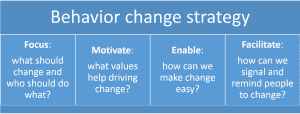
Behaviour Change strategy © Frits Hesselink
LEARNING FROM OTHERS
A protected area was struggling with visitor behaviour and the threats posed to biodiversity. Every year, the situation got worse with stakeholders blaming each other for the problem.
To create a change strategy we focused on one species and answered the questions “when is it threatened and by whom?” The species was the Greater Pasque flower. The ‘when’ was the protected area’s May 1st celebrations, and the ‘who’, the people who attended the celebrations. During the celebrations people camped, parked and rode motorbikes everywhere causing chaos disregarding the Pasque flower.
Using focus groups, people told us they loved the area and wanted to make May 1st May a festival for people and nature. They agreed to manage the event that made new behaviour easy, by introducing roadblocks, free busses and designated locations for camping and fires. The protected area managers signalled the need for change and informed stakeholders how they could contribute. A feeling of pride amongst the stakeholders was generated that the area was home to such a rare plant.
Ten years later I learned that the whole municipality was now involved in managing the successful event: The hunters had moved their corn field for wild boar away from the flower; the mountaineers had made a nature trail and a car park in the village; and the villagers were now actively promoting the area’s biodiversity. What was the recipe for this success? We helped them to do what they already wanted to do, triggered the right sequence of baby steps and a momentum of success. We made it a fun experience making it easy for them to change their behaviour.
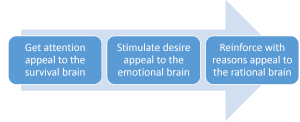
Process © Frits Hesselink
Similar case studies are available on the Frogleaps website (www.frogleaps.org). More communication news is on the IUCN Commission on Education and Communication’s news blog: www.cectalksnature.org.
Are you interested in developing your communication skills?
Check our brand new Toolkit “Be a Better Communicator”, with dozens of articles and useful tips to get you started right away!
